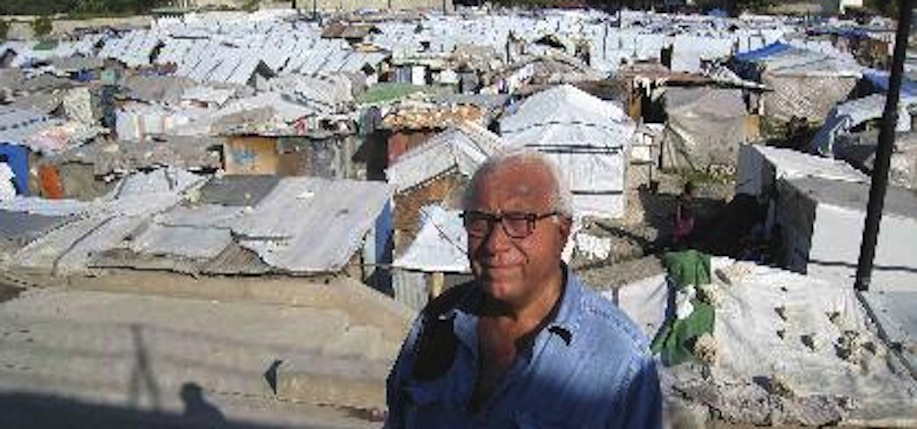Tom Moran, chairman of Mutual of America, is also chairman of the Irish relief organization Concern Worldwide U.S. which has been working in Haiti since 1994. He recently returned from Haiti, where he witnessed Concern’s efforts on behalf of the survivors of the earthquake. This is his report.
Fr. Aengus Finucane, a founder of Concern Worldwide and the honorary president of Concern Worldwide U.S. until his death one year ago, often reminded us that in order to truly understand poverty you had to see it with your own eyes and breathe it into your lungs. Only then, he said, will you know poverty and the strength and resilience of the people with whom Concern works throughout the world.
This past October, Joe Coppotelli, vice chairman of Structure Tone who will be honored at the annual Concern Worldwide Seeds of Hope dinner, took the time from his busy schedule to visit Concern’s programs in Haiti with me. He returned with an understanding of exactly why support for Concern is so important.
Our first stop with Joe was to visit a temporary housing camp at Place de la Paix that became home to over 18,000 people displaced by the earthquake. A large part of this particular camp was built within the walls of a football stadium. What you quickly realize when you first visit Haiti is that any open ground, whether it was a football pitch or a park, was immediately taken over by the people displaced by the earthquake. Tent cities popped up everywhere. These temporary shelters were initially constructed of little more than plastic sheeting. Of course, the haphazard manner in which these open fields were transformed into temporary housing camps complicated other issues which quickly became critically important to the safety and health of the people living in the camps. Concern understood that the people would suffer a further disaster unless they had access to improved housing, safe drinking water and proper hygiene. These makeshift dwellings were far worse than what most people could ever imagine as living quarters. Concern responded by bringing in experts from around the world to develop innovative solutions that were almost immediately put in place in an attempt to address the greatest and most immediate needs of the camps Concern was serving.
Ten thousand gallon water bladders were placed strategically to address the need for water, a Concern engineer designed a latrine system which was subsequently adopted by the UN as a model, shelter improvement kits were distributed, and solar-powered lighting was added in the camps to those areas with the heaviest foot traffic during the night. And work-for-pay programs involved the community in creating solutions. The streets of Port au Prince are still being cleared of earthquake debris by individuals who report every morning as part of the cash-for-work program.
There are no easy solutions to the issues of intense poverty in the world and there are certainly no quick fixes to the earthquake in Haiti, which in less than a minute left more than a million and a half people homeless.
In March of this year, I visited a site on the outskirts of Port au Prince called Tabarre Issa which was then 24 acres of muddy land.The government had bought the site as part of its plan to move families from the most overcrowded tent cities to a more spacious, cleaner environment. Concern took the challenge of managing this large project which would build new homes for 1,500 families. From the outset, Concern sought to engage the local community in the nearby village of Gallet Griffin and agreed to help rebuild 750 houses – which had been damaged or destroyed in the earthquake. The residents of Gallet Griffin, and those families invited to move to the new site at Tabarre Issa there, were consulted at every step taken to ensure that what was being built would be a new neighborhood, not a regimented camp.
Within a matter of weeks, the site was leveled, proper drainage installed, and the land was transformed into a planned community with temporary family-size tents in place. Across the road, the same provisions were being made for the people of Gallet Griffin. Returning, in October, we saw that Tabarre Issa has progressed even further, now offering safe and dignified transitional living quarters for families to live in while they put their lives back together.
Importantly, the work in Tabarre Issa is being done by local residents who have been trained under Concern’s cash-for-work program. Houses are now going up at a rate of between 5 and 10 per day. It is remarkable to see how much has happened since March. There are new roads, health services and schools now provided for the residents.
Questions continue to be raised about the lack of progress being made for so many of the more than one million people who continue to be suffering in Haiti. One week before we arrived, the cholera epidemic had already killed 300 people outside of Port au Prince. The fear of this epidemic reaching the congested tent cities in Port au Prince and spreading uncontrollably could be felt everywhere we went. One week after we left, Hurricane Tomas was moving towards Haiti with the threat of floods exacerbating the cholera epidemic. As we left, Concern was already distributing hygiene kits and hydration packs. The water supplied to the camps was being treated with chlorine and the teams were preparing for the hurricane.
Thinking about all of the problems still facing Haiti, it seems easy to despair. Yet, just recently there was a soccer match between Tabarre Issa and Gallet Griffin, the two communities. Despite all of the problems still facing these communities, on that one day there was the healthy competition of friends enjoying a Sunday afternoon together. If they can retain their humanity and optimism, how can we possibly despair?
Let’s not give up on the children of Haiti who continue to need our help!


Leave a Reply